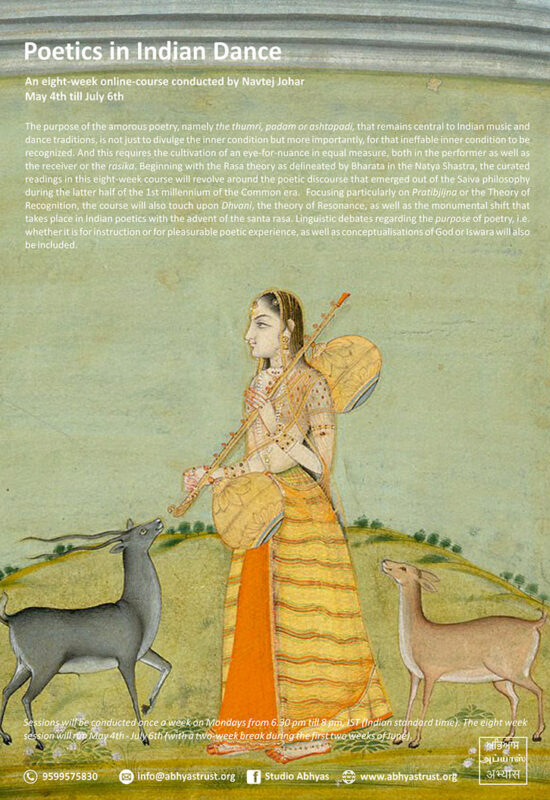The 8 weeks online course on Indian Poetics commenced on 30th July 2020 and till now we have completed 4 classes. It wouldn’t be an exaggeration to say that the course is inspired, and it expounds on the previous course offered by Studio Abhyas and taught by Navtej Johar – Taming of the Sensory Body: Memory. Text. Idea. The TSB course was primarily geared towards practitioners of yoga and dance who were seeking to academically engage with the historical, philosophical, and political redefinitions of their embodied practices over the last century and a half. The course on Indian Poetics, on the other hand, develops itself further and touches upon poetics from the perspective of Sanskrit grammar, aesthetic theory, as well as practice. It looks into the traditional/canonical texts like Bharata’s Natyashastra, its commentary, Abhinavabharati, by Abhinavagupta, the Kavyaprakash by Mammata, and so on. The course dives deep into the bhava-rasa theory; the aesthetic-poetic savouring as the larger topic of discussion.
In the first class Navtej Johar introduced the participants to Samkhya Philosophical School, samkhya means numbers or enumerations. This philosophy bases everything on the phenomenon (matter) and there is an absolute absence of God in this philosophy, i.e. it is resolutely silent on God. Navtej explains it as a school of thought that is focused singularly on the phenomenon and its methodical categorizations, it categorizes or “counts” matter and its distillates for the sake of “that” that cannot be counted. A school of causation it views the relationship between cause and effect as such, where – 1) the effect no matter how subtle or intangible is real. It has a being. It is. 2) The effect already exists in the cause. Like the tree already exists in the seed. 3) The cause is always subtler than the effect, and there remains a correspondence between the two. Navtej also explained briefly about the 6th Chapter of Natyashastra on rasa where Bharata’s disciples question him on the rasatwam of rasa or the rasa-ness of rasa and where it originates, and what do bhavas have to do with it.
The subsequent classes explored some important terms and ideas of Sanskrit Poetics and discussed ways of creating one’s methodologies, creative constellations out of things, ideas, and words that spark curiosity. As we moved forward with the course we meditated on the terms –
bhu the instable is. A perpetual isness. A continuous state of becoming and unbecoming. bhava a wishful existence. There is a fluidity of isness in bhava. When restlessness emerges in bhava it becomes bhaava – a wilful assertion. It is bhaava which is the key ingredient in abhinaya or any other creative, art-making process. abhinaya is an activity, i.e. a kriti. abhinaya is the externalization of one’s interiority; it is the method of making feeling (bhaava) transparent so that it is seen. Additionally, we discussed the spaces and processes of poetic encounters from the Natyashastra, and what helps us to achieve it. What is the objective of vi-bhaava, the imagined poetic object, and how it makes the poet/performer it’s subject in poetry or theatre to orchestrate anubhaava or experience?

